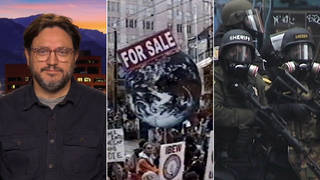
In California, a controversy is escalating over claims of abusive and racist treatment in the state prison system. Governor Arnold Schwarzenegger and state senate leaders announced this week they are backing a full-scale investigation of alleged racism and cruelty by guards at the High Desert State Prison in Susanville. Officials said the move came in response to a two-part exposé published Sunday and Monday by the Sacramento Bee. The Bee investigation found evidence of brutality, cruelty and corruption by correctional officers at a special behavior modification unit at the prison. Prisoners describe strip-searches in a snow-covered exercise yard, as well as guards who assaulted prisoners, tried to provoke attacks between inmates, and spread human excrement on cell doors. Charles Piller is the investigative reporter at the Sacramento Bee who broke the story. [includes rush transcript]
Transcript
JUAN GONZALEZ: In California, a controversy is escalating over claims of abusive and racist treatment in the state prison system. Governor Arnold Schwarzenegger and state senate leaders announced this week they’re backing a full-scale investigation of alleged racism and cruelty by guards at the High Desert State Prison in Susanville.
Officials said the move came in response to a two-part exposé published Sunday and Monday by the Sacramento Bee. The Bee investigation found evidence of brutality, cruelty and corruption by correctional officers at a special behavior modification unit at the prison.
AMY GOODMAN: Prisoners describe strip-searches in a snow-covered exercise yard, as well as guards who assaulted prisoners, tried to provoke attacks between prisoners, and spread human excrement on cell doors. Prisoners depicted an environment of brutality, corruption and fear, that included the withholding of medical care, racial slurs and an apparent cover-up of abuse allegations by prison officials. The series also described extreme isolation, idleness and deprivation in similar units at other prisons.
Charles Piller is the investigative reporter at the Sacremento Bee who broke the story. He joins us now from Sacramento.
Charles, welcome to Democracy Now! Just lay out what you found.
CHARLES PILLER: Well, what I found was a troubling pattern of behavior, particularly at High Desert, but also, to some degree, extending to other prisons in the California system that have these — what were originally called “behavior modification units,” and then the name was changed some years later to “behavior management units,” as a way of removing the taint from the old days of behavior modification in prisons that involved even more horrific kinds of experiments on prisoners.
Now, I originally heard of this story — I heard that a report had been created by the state’s own correctional researchers that looked closely at the behavior modification unit at High Desert and found evidence, based on the testimony of a number of different prisoners, that they had experienced this kind of cruelty and brutality, including beatings, including the shackling of one prisoner, and having him be pepper-sprayed at point-blank range, not decontaminated, and paraded naked through the cell block in a way that that prisoner and others who witnessed the event regarded as a kind of image of modern slavery. This was a pretty alarming set of facts to learn. And so, of course, I wanted to look further.
I was able to corroborate all of the stories that the state researchers originally found out and also extend that to a variety of other very troubling allegations associated with beatings, contamination of food supplies. And probably, in some ways, the most troubling, in a way, of these issues was the destruction of evidence associated with the claims and the corruption of the process that prisoners have to be able to protest conditions that they regard as inhumane.
JUAN GONZALEZ: Now, these behavior management units, how do they differ from what’s normally referred to, I guess, as isolation cells in these prisons? And what are they supposed to do that’s different from those isolation cells?
CHARLES PILLER: Yes, well, these units were established, I think, for a good reason, which is that normally in the state prisons here, there are essentially two options. There are the general mainline prisoners, and then there are — for prisoners who break prison rules or are violent, there’s something called the security housing units, sometimes called “the hole” by prisoners, and also something called administrative segregation. These are very secure areas that are sort of prisons within the prisons. What officials thought was that they needed an intermediate step, something that would create incentives and also disincentives for rule breaking. And these so-called behavior modification units were based on that.
They had carrots and sticks associated with them. The sticks were a reduction in privileges. Prisoners lost contact with family members, in many cases. They lost time in the exercise yard. They lost the ability to draw from the prison canteen. They lost access to electronic media, such as television, very restricted access to reading materials. Kind of an isolation tank, you might say. And the carrot was that for good behavior, in other words, reduced rule breaking in the prisons, they could gradually earn back a few of those privileges and eventually graduate into the mainline prison environment, where they could be a more — have a more normal prison experience.
The path was something called “life skill” classes. These were things like anger management and Alcoholics Anonymous, things that prisoners could use to essentially heal themselves, at least by design. What I found was that these classes were largely dropped by the prison system. In other words, budget cuts and lockdowns, where prisoners are locked in their cells, often, all but all week, every week, except for perhaps two or three visits outside the cell for a quick shower, in many cases — these kinds of conditions made the classroom part of the program increasingly meaningless. And so, what you were left with was fear and deprivation. Now, fear and deprivation can be a powerful motivator. As a result, the prisons reported that these were successful programs. They reported that rule violations were down as a result of the behavior modification program.
Unfortunately, it came at a great cost. That cost was constitutional rights violations and brutality, that were not just uncovered by my series, but also reported by the state’s own researchers. So what was very puzzling about this is that the state knew about these very serious allegations. They had people within their own ranks of their official research team reporting these and voicing concern about these allegations for more than two years and basically did nothing about it.
AMY GOODMAN: Tell us —-
CHARLES PILLER: Nothing about it, I should say, until our series was published.
AMY GOODMAN: Charles Piller, tell us about Jason Brannigan.
CHARLES PILLER: Yes, Jason Brannigan, who was incarcerated for armed assault, is actually a born and raised resident of Sacramento. He is currently in Sacramento County Jail for a alleged parole violation. This guy is a guy who has a criminal past. And I think viewers may logically say, “Why believe a guy like that?” Prisoners do lie. They aren’t the most credible sources, because they’re constantly trying to game the system. So what we did is we did a multi-part test to try to assess the credibility of prisoners. We relied on the state’s own researchers, who did believe that these were serious and potentially true allegations, and we did our own research.
But just to get a description of Jason, this is a prisoner who was housed in the behavior modification unit at High Desert. And this is the scene he described, which we found to be credible because we were able to corroborate it in documents and also in the testimony and comments of several witnesses to the scene. He refused to return his food tray after a meal was given to him by the prison authorities. And this was after he was given two to three minutes to complete his meal, the typical amount of time that prisoners in that unit were allowed to eat their meal. And he was told to present his hands backwards through the food slot to be shackled, which he did. He was handcuffed. And then the guards were preparing possibly to come into his cell and take him out. He unfortunately was -— claimed to be wedged into a position in the cell, where he was trying to get the attention of guards, where it was not easy for him to stand up and immediately come out of the cell. The guards reached into the cell through the slot for food and pepper-sprayed him at point-blank range. I don’t know if any listeners here understand how excrutiating that can be, but especially if you’re pepper-sprayed on the face and head at point-blank range, it’s extremely painful. He was then pulled out of the cell — beaten in the cell, pulled out of the cell, so he and other witnesses say, and shackled hands and feet, stripped naked, and paraded through the cell block in front of not just other prisoners, but also in front of a large number of guards, including female guards. So, as you might imagine, this was a humiliating experience and also one that Brannigan claims was damaging to his eyesight, because he was never fully decontaminated during this episode, which lasted quite a long time.
This is an example, I think, an egregious example, the prisoners said, of a kind of racism that they experienced on a daily basis, including a large number of racial slurs and including actual comments by the guards at High Desert State Prison that the African American inmates shouldn’t receive the same kind of attention and respect that other inmates in the unit received.
Now, these, of course, are allegations; they haven’t been proved in a court of law. But we found them to be compelling, because they were so well supported by inmates who I interviewed at prisons all over the state system. These were people who could never have easily found a way to collaborate on a story, and yet the stories they told were remarkably similar, recounting the same incidents, the same sorts of treatment, the same kinds of hearing of racial slurs, that they kind of rang true after a while. They convinced us that there was something worth investigating by the state, and I might add, fortunately, after the series appeared, they did convince the governor and the top leaders of the state senate that such an investigation should take place.
JUAN GONZALEZ: You also wrote about inmates —-
CHARLES PILLER: I should add, if I may -—
JUAN GONZALEZ: Yes, go ahead.
CHARLES PILLER: I should add that I want listeners to understand that most correctional officers do their jobs professionally and well, even in the difficult conditions of overcrowding in the California prisons, and they deserve a lot of credit and thanks for their public service in an often dangerous and difficult job. The story was not meant to cast aspersions on that profession. It was meant to point out credible and, I think, quite compelling allegations of abuse by people in a certain setting and abuse that should be investigated and looked at fully, not to say that all guards or all correctional officers behave in a reprehensible fashion.
JUAN GONZALEZ: Well, you also reported, for instance, inmates such as Rufus Gray and others who were strip-searched and marched in the snow and marched through snow-covered areas. Could you talk about that? And what was the response of prison officials to some of the reports that you exposed?
CHARLES PILLER: Yes, well, this kind of episode, where prisoners are taken out into the exercise yard — and you have to understand, High Desert State Prison is in a mountainous area where it can be quite cold during the winter months, often a lot of snow there — they would often be taken out there. And from what I understand from inmates who are still in contact with me, these kinds of searches still go on today. They would be taken out into the exercise yard in the snow, strip-searched for searches that sometimes lasted two hours or more. And while they were being strip-searched out there, the officers would be searching for contraband in their cells. These searches often involved the destruction of personal property, such as family photos, in a gratuitous way that was meant to harass the inmates rather than serve any real purpose for the institution.
Now, the prison officials who I interviewed, in particular, undersecretary of the system in California Scott Kernan, he regarded these kinds of complaints as routine and the typical kinds of complaints that prison officials receive from inmates in restricted areas. What was puzzling to me was that he didn’t seem to regard these as sufficiently severe conditions to launch an investigation based on the reports, not even from the Sacramento Bee, but from the researchers of the corrections’ own system. These reports were kept quiet. They were kept silent. And the researchers themselves who protested were muzzled for an extended period of time, while they tried to get the word out. They were alarmed. They didn’t necessarily believe the allegations, but they felt that they were sufficiently credible that they deserved a close look by prison officials. Officials stopped that investigation from going forward. They hid the report that the researchers produced. They hid the report for an extended period. And it was not until I was able to obtain a copy of that report and do additional research to validate the concerns that were raised that officials started to take notice of the problem.
AMY GOODMAN: Charles Piller, we want to thank you very much for being with us, investigative reporter for the Sacramento Bee. We will link to your series on cruelty, racism and cover-up in the California prison system at democracynow.org.












Media Options